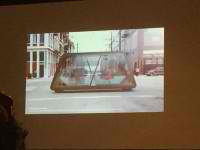Population and economic growth in cities over the next 15 years out to 2030 will have an impact on buildings, energy, infrastructure projects, transport, waste and the workforce.
Zoe Sprigings, Head C40 Cities Climate Leadership, Group’s Energy Initiative says.
 Cities themselves have much to gain from adopting more compact, connected and efficient forms of development: healthier, more livable and more productive cities.
Cities themselves have much to gain from adopting more compact, connected and efficient forms of development: healthier, more livable and more productive cities.
If managed well, the potential benefits of urban growth are substantial, in particular allowing concentration of national economic growth and the roll out of innovative infrastructure and technologies.
Taking the Smart City Wien Framework Strategy as a leading example, this is an approach to 2050 for Vienna which was adopted in June 2014. There are three fields of action including Resources – Quality of Life – Innovation.
Across the 6 objectives covering energy, mobility, buildings, innovation, social affairs/health-care and the environment is the requirement for 21st Century careers and smart cities workforce capabilities.
Alongside targets for reduced resource consumption and social inclusion, “the city belongs to all” this strategy describes A city for young people from all over the world,
Favourable economic policy conditions and cutting-edge technologies create a diversified employment landscape with a sufficient number of workplaces that are highly compatible with family life and children. Internationally, Vienna is considered a leader in products and services pertaining to energy, mobility, sustainability and health. These assets attract young people from all over the world, who find possibilities for a fulfilled and happy life in Vienna. Even long-time residents of the city have caught this “bug”. (Smart City Wien Framework Strategy Overview)
Innovation is in all fields including enterprises and scientific institutions preparing for the challenges for a knowledge-driven economy.
What does it mean for the workforce?
These smart city objectives mean that the workforce must have capabilities for the 21st Century, i.e. the “century of cities”, which includes:
- Adaptable and willing to learn
- Approach change actively
- Collaboration and inspiration
- Globally competitive
- Innovation and motivation
- Knowledge creation and management
- Resilience and flexibility
- Research and technology
- Resource conservation
- Social cohesion and inclusion
Moreover this means attracting headquarters, encouraging people to set up enterprises and increasing the export volume for technology-intensive products.
Improving continuing education rates beyond compulsory schooling, attainment of higher educational levels, providing second-change education and the recognition of foreign educational attainments by adults will be important.
Describe as an engine for job creation and economic growth, the types of jobs and how work happens in smart cities will change with new emerging in demand job roles including:
- Robotics specialist
- Cyber security analyst
- 3D print technician
- Virtual reality design
- Network programmer (SDN)
- Machine learning scientist
- Industrial network engineer
- Customer makers
- Neuro implant technician
- Professional triber
- Digital anthropologist
- Platform developer
- Business transformation practitioner
- Cloud architect
- Data scientist
- Urban innovation/Urban mechanics
Source: http://www.techrepublic.com/article/16-tech-jobs-that-will-be-needed-for-the-future-of-smart-cities/
Image: Cisco Systems
What next?
If your city or region is considering developing a smart city strategy and/or you have a plan for growth then you must have a workforce to match.
To talk through how this might work please send an email to wendy@wb.switchstartscale.com.au and make a time for a chat about your aims, objectives and current workforce profile. If you are in the education sector please get in touch about our new 21st Century Careers Program that can be delivered over 1 or 2 years. Thank you.
April 2016


